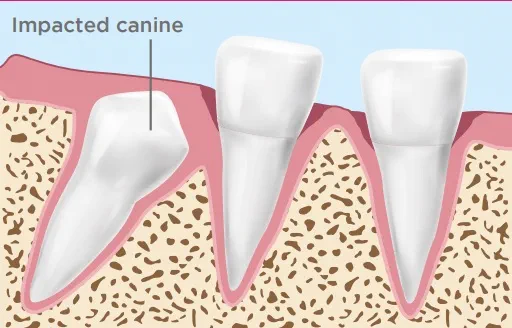Navigation
Impacted canines
Canines are your corner teeth. They help give you a balanced and symmetrical smile and there are two in each of your jaws.
Canines can become impacted. This means, instead of growing in your mouth, they stay buried in the jawbone beneath your gum.
They can be commonly treated using a combination of fixed braces and surgery, or they may not need treatment at all.

How do I know if I have impacted canines?
No one knows why canine teeth become impacted. But up to 3% of the population will experience an impacted canine. And 85% of these cases occur under the gum in the roof of the mouth1. Some people have no symptoms and others have painful symptoms such as:
Swollen or bleeding gums
A bad taste in your mouth
Bad breath
Pain when chewing
Impacted teeth can damage the roots of the teeth next to them. There’s also a possibility that cysts will develop near them and these can become infected.
If you think you may have an impacted tooth, it’s important to get it checked by an orthodontist so they can advise you on whether you need it treated.
How are impacted canines treated?
There are several options for treating impacted canines, which will depend on:
- Where your canine tooth is buried
- Whether you want to wear a fixed brace
- Your age
- The space available for the canine tooth
- How long treatment might take
The four treatment options available include:
Option 1: No treatment
If the impacted canine isn’t causing you any problems, then your clinician may suggest leaving it. They may X-ray it occasionally, just to ensure it isn’t causing problems.
Treatment may be necessary later on if any oral health problems start to develop, or if you begin to have painful symptoms.
Option 2: An operation to uncover the buried tooth
Uncovering the buried tooth involves removing a small ‘window’ of gum and bone to help it grow into your mouth.
In some cases, a gold chain or brace attachment gets attached to the tooth during the operation, or later on in the treatment. You’ll then need to have fixed braces to shift the canine into the correct position. You may also need to have teeth removed to make space for the canine.
Option 3: An operation to remove the buried tooth completely
This option may be suitable if:
- You don’t want to wear a fixed brace
- The rest of your teeth are straight with no gaps
- The buried tooth is in a poor position
- The buried tooth is causing issues
You may require further dental or orthodontic treatment in the future if this leaves you with a baby canine tooth or a gap.
Option 4: An operation to ‘transplant’ the buried tooth to its proper position
This is a rare treatment option, as it has a lower success rate than the other options, and there needs to be enough space between the teeth. If your orthodontist feels this is a suitable treatment option for you, they’ll explain what’s involved in more detail.
Spread the cost of your treatment†
Get the straighter smile you’ve always wanted with finance options that suit you, including 0% APR up to 36 months or 7.9% APR over 48 or 60 months.
Ask us about hassle-free finance with Novuna Personal Finance today. T&Cs apply.
What to expect
At your consultation, we will chat through your options and suitability for different teeth straightening treatments.
*Terms and conditions:
1. Free consultations are to discuss options and suitability for treatment. You may require a more in-depth clinical examination or diagnostic tests before treatment options can be discussed. There may be a charge for such examination or test, payable by you. The clinician will discuss this with you before any such examination or test takes place, which may be done during the same appointment as your free consultation.
2. Consultations subject to availability.
3. Free consultations available at participating practices only.
We recognise that when you give us personal information (which includes health information) you’re trusting us to take good care of it. Please see www.bupa.co.uk/privacy for more information about how we collect, use and protect your data.
If you don’t want to receive marketing about Bupa products and services that we think are relevant to you, please contact us at [email protected].
Find out more
Teeth straightening
Everything you need to know about getting a straighter, healthier and more confident smile.
Types of braces
Discover our teeth straightening treatments, from traditional fixed braces to removable and discreet options.
About Total Orthodontics
Find out why you might want to choose us for teeth straightening treatment.
1 Source: British Orthodontic Society, Impacted Canines, Patient Information Leaflet, March 2019.
Our orthodontists
†Finance terms and conditions:
Finance applicant must be aged 18 or over, a UK resident, have a UK bank account and be in permanent employment. All loans are subject to eligibility, status, affordability and a credit check. T&Cs apply. Finance is available on private dental treatments only.
The minimum spend for finance is £250 and the maximum is £50,000. 0% APR representative is available on repayment terms of up to 36 months subject to the amount of credit. Finance taken at repayment terms of 48 or 60 months is subject to 7.9% APR representative.
Total Orthodontics and Bupa Dental Care are trading names of Oasis Dental Care Limited, Vantage Office Park, Bristol, BS16 1GW, whose company registered number is 00478127. Oasis Dental Care Limited is authorised and regulated by the Financial Conduct Authority FCA registration no: 710559. Oasis Dental Care Limited is a credit broker and not a lender.
Finance is provided by Novuna Personal Finance, a trading style of Mitsubishi HC Capital UK PLC, authorised and regulated by the Financial Conduct Authority. Financial Services Register no. 704348. Registered Office: Novuna House, Thorpe Road, Staines-upon-Thames, Surrey, TW18 3HP. Registered in Cardiff under company no. 1630491. The register can be accessed through; http://www.fca.org.uk/.